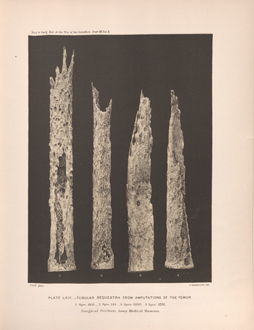Title: McMahon, J.
Source text: The Medical and Surgical History of the War of the Rebellion. (1861-65.), Part 3, Volume 2 (Washington, DC: Government Printing Office, 1883), 223-224.
Civil War Washington ID: med.d2e10451
TEI/XML: med.d2e10451.xml
CASE 435.—Private J. McMahon, Co. I, 6th New York Cavalry, aged 23 years, was wounded in the left leg, at Todd's Tavern, May 7, 1864. He was admitted to a field hospital of the Cavalry Corps, where amputation was performed but not recorded, and five days afterwards he was transferred to Washington. Assistant Surgeon W. Thomson, U. S. A., made the following report of the case: "The wound was caused by a musket ball, which caused a fracture of the femur extending into knee joint, for which amputation was performed at the middle third, by the circular method, within an hour, chloroform being used. He was admitted to Douglas Hospital May 12th, at which time a large slough existed on the anterior flap, which soon separated, exposing the end of the bone. There was no vigorous effort at repair, the granulations being pale and flabby. The patient's general condition was unfavorable; he was much depressed and very pallid, and had a severe diarrhœa. On June 20th, the cellular tissue of the stump again began to slough, and, on the 22d, it was found requisite to apply pure bromine. On the 23d most of the sloughs separated, and, by the next day, the stump was clean and the granulations more florid and healthy. One inch and a half of the end of the femur was in a state of necrosis and protruding. On August 11th, a sequestrum, nine inches in length, was removed by extraction, leaving a deep cavity in the stump, which was bounded externally by a large and firm cylinder of new bone. The patient's improvement was then rapid, and, by November 1st, he was considered convalescent. This man had remained for weeks as pale as death and so feeble as to be unable to lift his head from his pillow. He seemed daily on the verge of the chill of pyæmia, and his case was recognized and pointed out as one of osteomyelitis of the femur, from which if death did not result a long exfoliation would be removed." On May 18, 1865, the patient was discharged from service, and several weeks after he was furnished with an artificial limb by the firm of A. A. Marks, of New York City. In his application for commutation, dated 1870, the pensioner stated that the amputation was performed by Assistant Surgeon S. C. Sanger, 6th New York Cavalry, also that the stump was in a healthy condition. The pensioner was paid June 4, 1879. The sequestrum (Spec. 4281) was contributed to the Museum by Dr. Thomson, and is shown, reduced in size one-third, in FIG. 4 of PLATE LXIX, opposite.
